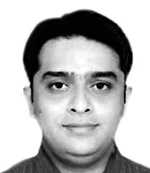Electricity for “GeoSmart India”
Speakers and Presentations

ANAND KUMAR S V
Assistant Vice President - IT
Reliance Energy Limited

Vivek Shandilya
Assistant Manager (Automation)
Noida Power Company Limited

Pramod Kumar Parida
Scientist
Odisha Space
Applications Centre

Ralph D' Souza
Industry Sales Manager-Power
Bentley Systems India

Tarun Batra
Head of Group – GIS, Tata Power
Delhi Distribution Limited
Presentation on:Geospatial Enabled Business Processes for Electric Utility

Ravindra Kumar Verma
Chief Engineer
Central Electricity Authority

Amara Raja
Junior Manager
Cyient

A K Shrivastava
Addl GM (IPDS)
Power Finance Corporation
Presentation on:GIS Implementation in Power Distribution Companies in India

Sumit Gupta
Head-Energy, Utilities & Smart Cities
SAS Institue (India) Pvt Ltd.
Presentation on:SAS Based Analytics for Electric Utilities in India

Alekhya Datta
Associate Fellow
The Energy Resources Institute
Presentation on:Development of Utility Specific Smart Grid Roadmap, and Implementation Strategy for Smart Grid Technologies

Vikas Gupta
Sr. Manager-GIS
Noida Power Company Ltd.
Presentation on:GIS Implementation in Discoms – Avoiding Mistakes

Samir Banger
Head-GIS
BSES Yamuna Power Limited

Ajay Kumar Sharma
Project Manager
RMSI
Presentation on:Automated electric wire extraction from LiDAR point cloud data

Arun Raj
Avineon India Pvt Ltd.
Presentation on:GIS Web Portal for Electric Utility

Sivagurunathan S
Senior Manager-Electicity
Geospatial Media & Communications
Introduction
Indian Power Sector has grown leaps and bounds in the last few decades and there has been significant development in generation, transmission and distribution of electricity.
Challenges - Indian Power Sector:
- Deficit in power supply
- High T&D and AT&C losses
- Low per capita consumption
- Inefficient Distribution System
As far as power generation is concerned, the Government of India has set a target to double the annual power generation from the present levels of 1,023 BU and this is expected to make the country energy surplus. In order to improve efficiencies, the Government has plans to replace the old thermal power plants with supercritical power plants; enhance the plant load factor of power stations and assure the supply of fuel (mainly coal and gas). The Government is also promoting green technologies through an ambitious target of 175 GW of renewable power by 2022. It is estimated that investments to the tune of US$ 250 billion will be required for implementing these capacity addition and modernization projects.
Key Actions:
- Capacity Addition
- Technology Upgradation & Modernization
- Renewable Energy Integration
- Smart Grid/ IT & Communication/ Automation
Power is transmitted through Extra High Voltage and High Voltage Direct Current networks and the availability of power transmission system in India has reached significantly higher levels. The transmission and distribution losses in the country are still higher; the distribution sector is still recovering from the huge aggregate technical and commercial losses (25.38 % for the year 2012-13). The Government of India is actively involved in promoting a lot of initiatives to reduce these losses to 15 %. In order to improve efficiency and reliability of power distribution in the country, smart grids are also promoted by the Government of India. Geospatial Media believes that geospatial technologies would play a major role in achieving greater efficiencies in electricity sector in the country. Keeping this in view, Geospatial Media is organizing a program on electricity in its “GeoSmart India” Conference that is planned to be held in Greater Noida from 1st till 3rd March 2016.
Geospatial is a terminology used to denote Geographic Information System (GIS), Global Navigation Satellite System (GNSS) (or Global Positioning System (GPS)), Earth Observation, Unmanned Aerial Vehicles (UAVs), Photogrammetry, Light Detection and Ranging (LiDAR), Radio Detection and Ranging (RADAR) etc.
Electricity Program and its focus
Introductory Session: Key Central & State Government programmes, policies and schemes for capacity addition, network expansion, modernization, smart grids etc.
The Government of India has taken a lot of initiatives such as Integrated Power Development Scheme (IPDS), Restructured Accelerated Power Development and Reforms Programme (R-APDRP), National Smart Grid Mission (NSGM) etc. for capacity addition and modernization of electricity infrastructure in the country. The following aspects of these initiatives will be discussed in this introductory session:
- Government’s Programmes/ Policies/ Initiatives, challenges and progress
- Review of similar programmes in other countries, learnings and experiences
- Value of geospatial technologies for the success of these programmes
- Way forward.
Thematic Sessions
Session 1: Geospatial technologies & solutions for electric utilities
Part 1: Solutions for visualization
GIS is the widely used geospatial technology in the electricity sector for visualization purposes, especially by power distribution companies. GIS based solutions are used for various applications such as management of assets and records, workforce management, network planning, modelling and monitoring etc. If GIS is integrated with other systems like Outage and Distribution Management System (OMS/ DMS), SCADA, Advanced Metering Infrastructure (AMI) and business processes such as Enterprise Resource Planning (ERP), Customer Relationship Management (CRM) etc., the utility will enjoy a lot of benefits like efficiency improvements; productivity etc. Following aspects will be discussed in detail:
- Introduction to geospatial solutions for visualization, GIS for electric utilities, latest developments, global scenario, best practices
- GIS applications with benefits, RoI
- Integration of GIS with other systems/ business processes, challenges, benefits, RoI
- Case Studies/ Success Stories for major applications and integration.
Part 2: Solutions for data creation, inspection etc.
Geospatial technologies that are used for the creation of data, inspection etc. in the electricity sector would be comprehensively discussed in this session. GPS (or GNSS) devices are used for collecting latitude/ longitude information of transmission and distribution assets which in turn is used for the development of GIS database. GPS is also used for managing ground based workforce. UAVs coupled with LiDAR are used for the development of aerial images and also for the inspection of assets.
Session 2: Smart grids and the contribution of geospatial technologies
Smart grids are going to play an important role for raising the standard of electricity infrastructure in the country. Smart grid is all about anticipation of events and providing swift response to them. Smart grid includes smart meters, smart appliances, and integration of renewable energy sources, energy efficient practices and control and automation of distribution networks. Experts believe that location intelligence is the basis on which smart grids are built. Recently, the Government of India has launched “National Smart Grid Mission (NSGM)” in order to accelerate the adoption of smart grids in the country, especially for developing smart grid infrastructure in 20 cities in the country. Apart from that, as part of the Smart City Programme, 100 smart cities are planned to be developed and each one of them is going to have a smart grid. 14 pilot projects are implemented at various states in the country. This session will focus on the following aspects:
- Overview of smart grid programmes/ project implementations around the world, key learnings and experiences
- Latest developments, technologies and solutions for loss reduction & efficiency improvements
- Different aspects of smart grids including Advanced/ Smart metering, IT & Communication, Analytics, Network Automation, Demand Response, Peak Load/ Power Quality Management, Distributed generation/ Integration etc.
- Role of geospatial technologies in smart grids.
Target audience
The “GeoElectricity Program” will be beneficial for the following stakeholders engaged in the electricity sector:
- Administrators and Policy Makers: Central Ministries & Affiliated Organizations, State level Energy Departments, Central & State Electricity Regulatory Commissions
- Technology/ Products/ Solution/ Service providers in the fields of geospatial, smart grids etc.
- End Users: Power Distribution Companies (DISCOMs), Transmission Companies (TRANSCOs) and Generation Companies (GENCOs)
- Consultants working in smart grids, electricity infrastructure modernization, geospatial etc.
- Bilateral and Multilateral Organizations
- Project Developers
- Industry Associations
- Research Organizations
- Academic Institutions.
Objectives of “GeoElectricity Program”
The objectives of the program are as follows:
- Showcase and learn how geospatial technologies are used in electric utilities (through case studies, success stories etc.) and their benefits.
- Explore newer business opportunities and get new insights & directions.
- Knowledge transfer: Understand about global scenario, latest developments, industry trends and best practices (related to smart grids & geospatial technologies for electricity sector).
- Technology transfer: High-level exposure to the latest technologies that can reduce costs and inaccuracies and enhance the efficiency of business processes in electric utilities.
- Networking: Interact with major stakeholders from the electricity sector including administrators and policymakers, users, solution & service providers, project developers, scientists, academia and professionals from India and other countries in one hub and establish professional relationship.
